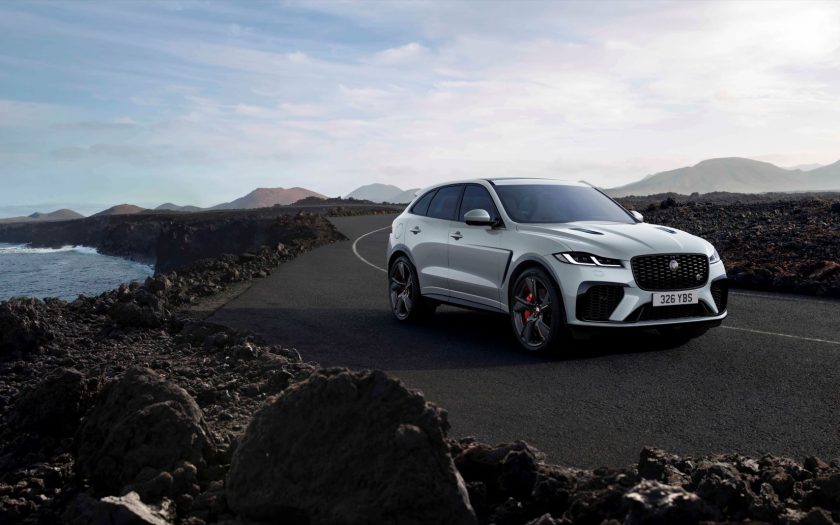Chris Riley tests the 2023 Jaguar F-Pace R-Dynamic D300 SE with pricing, specs, ride and handling, safety, verdict and everything the over-50 driver needs to know.
Summary: The big F-Pace is an appealing, if large, luxury SUV. And the options list can hugely inflate the price you end up paying.
2023 Jaguar F-Pace R-Dynamic D300 SE
Pricing: $105,300 (plus on road costs)
Options: sunroof $4420, 22-inch wheels $4420, head-up display $1960, privacy glass $950, drive control with adaptive surface response $310, 360-degree overhead camera $950, 12.1-inch interactive display $845
Warranty: Five-years/unlimited km
Safety: 5-star ANCAP (tested 2017)
Build location: United Kingdom
Engine: 3-litre turbo intercooled 6-cylinder direct injection diesel
Power: 221kW at 4000rpm
Torque: 650Nm at 2500rpm
Transmission: 8-speed sports automatic, all-wheel drive
Body: 4747mm (long); 2071mm (wide); 1664mm (high)
Weight: 2008kg
Towing capacity: 2400kg
Wheels: 20-inch alloy
Tyres: 255/50 R20
Ground clearance: 213mm
Fuel tank capacity: 68 litres
Official consumption: 7.0/100km (diesel)
Consumption on test: 8.0/100 (400km)
seniordriver consumption on test: not tested
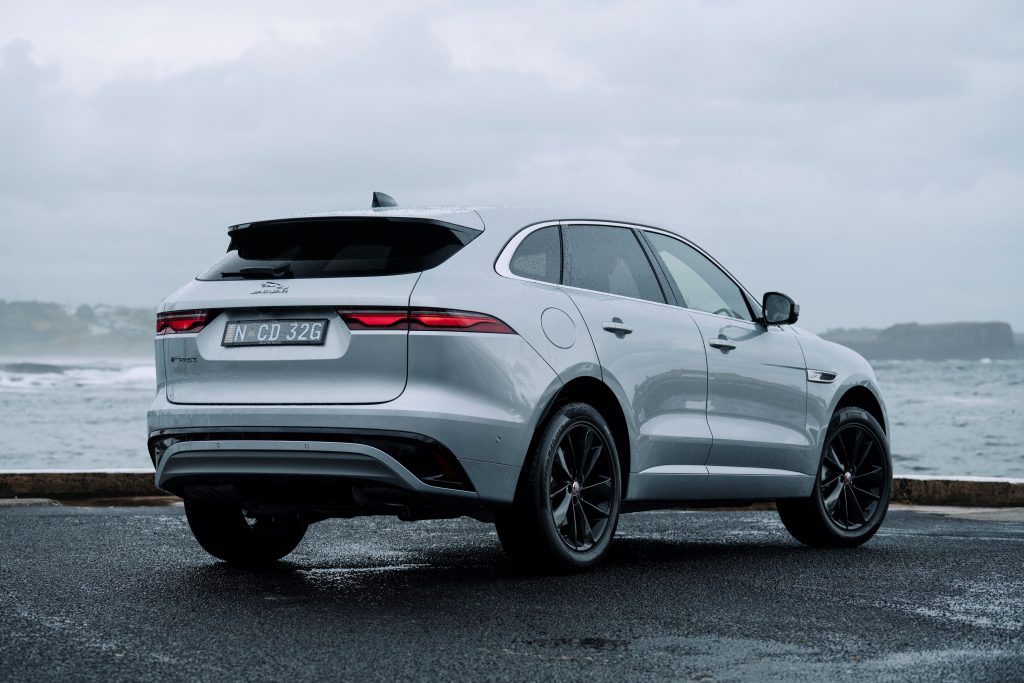
[review]
After spending a few days in one of Sydney’s wealthier harbourside suburbs, we were surprised to see few examples of Jaguar’s F-Pace.
The company’s first and largest SUV ticks all the boxes, or so we thought. It’s stylish, pricey and with its long British lineage – what more could one want?
Or so we pondered searching for a parking spot, on a long narrow street that was not wide enough for two vehicles to pass and which offered parking on one side only.
A small city car starts to make a lot of sense in this context, because the F-Pace is long and rather wide and finding somewhere to pop it is not accomplished easily.
In fact, parking the car can be a challenge full stop, because you can’t see over the bonnet and the auto dipping rear vision mirrors can be both a help and hindrance trying to guide it into a tight spot with scraping the rims (fortunately the dipping mirrors can be disabled).
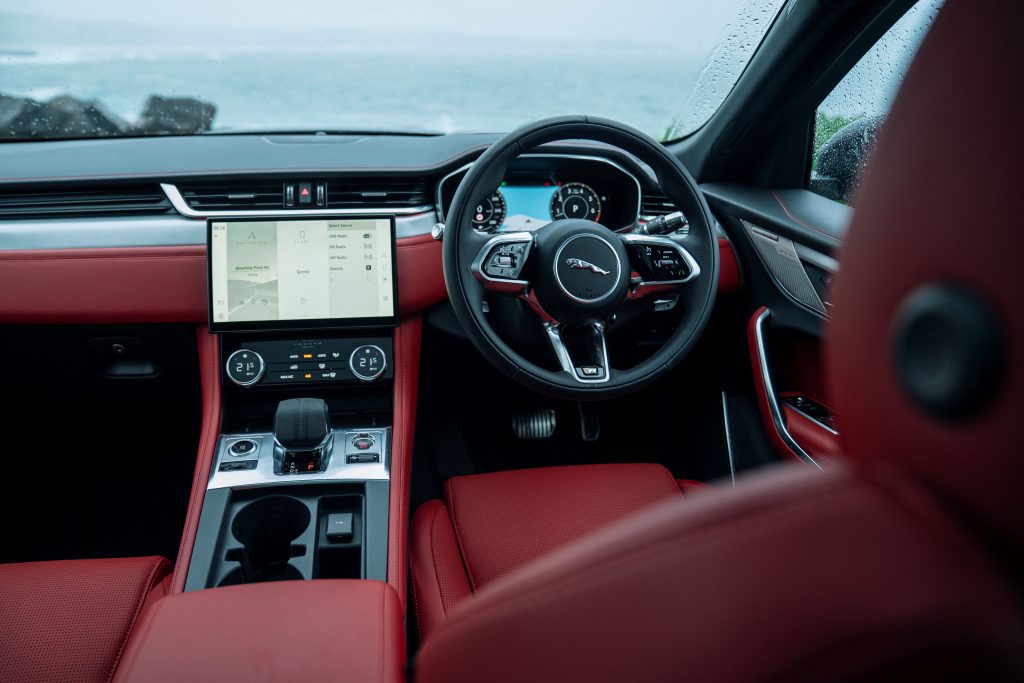
What’s it cost?
That gifted Scot Ian Callum designed the F-Pace.
As Jaguar’s very first SUV, he got to start with a clean slate.
Callum, who we’ve met more than once, is a believer that Jags should look cool because cool cars attract cool people – and the F-Pace largely achieves this goal.
Like his other designs the proportions of the five-seat SUV are near perfect, but we can’t help feel the front, lower air intakes could do with some embellishment – at least in this model.
They’re a bit large, a bit plain and appear designed to fill empty space more than anything else.
The radiator grille is starting to look a bit dated too, but of course it will soon be superfluous to needs.
The rear of the wagon with its broad haunches, chunky rubber and horizontal tail lights is beyond criticism.
F-Pace is offered with a choice of petrol and diesel engines, some turbocharged, others turbocharged and hybrid together while still others are all three: turbocharged, supercharged and hybrid combined – all underpinned by all-wheel drive.
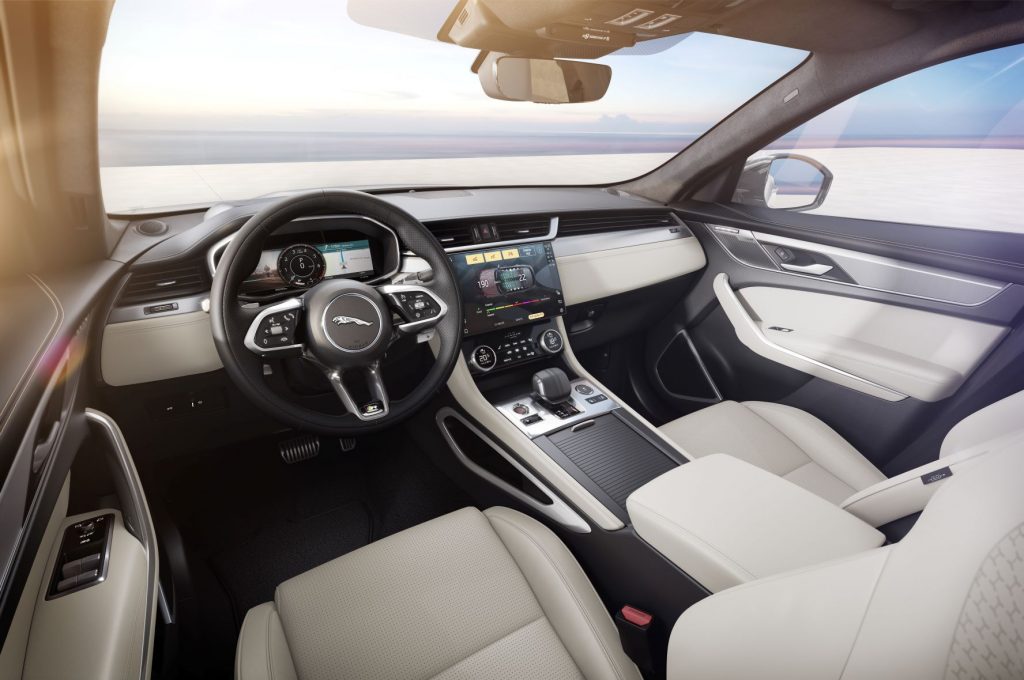
Prices start from $83,700 for the entry F-Pace R-Dynamic P250 S, with a turbocharged 2.0-litre petrol engine.
Our test vehicle, the R-Dynamic D300 SE powered by a 3.0-litre twin turbo diesel with a mild hybrid, is priced from $105,300 plus on-road costs.
The top of the line 5.0-litre supercharged V8 SVR P550 is priced from $155,100.
There’s pages and pages of options to personalise your car and contribute to the bottom line.
Determining what is standard and what is optional however could require confirmation.
Our test vehicle was fitted with a number of options that brought the total price to $115,399 (at the time of writing) before on-roads, including sunroof ($4420), 22-inch wheels ($4420), head-up display ($1960), privacy glass ($950), Drive Control with Adaptive Surface Response ($310) plus additional power sockets ($139) – 2 x USB and 1 x 12 volt for rear seat, 1 x 12 volt for luggage area.
The 22-inch wheels bring a tyre repair kit instead of the space saver.
Standard kit includes 20-inch alloys, black exterior pack, two zone climate air with rear vents, heated 12-way power-adjust DuoLeather sport seats with driver memory and configurable cabin lighting.
There’s also LED headlights, auto high beam, auto dimming interior mirror, auto lights and wipers, power fold and dip exterior mirrors, front and rear parking sensors and a power tailgate.

Infotainment consists of the latest Pivi Pro system with a floating 11.4-inch touchscreen that is quick to start and features Bluetooth, voice control, satellite navigation, AM/FM/DAB+ radio, wireless Apple CarPlay and wireless Android Auto and wireless phone charging, along with an online data plan.
The simplified menu structures allow drivers to access or view up to 90 percent of common tasks in two taps or less, we’re told.
The Meridian sound system pumps out 400 watts, with 13 speakers including a separate subwoofer plus active noise cancellation to remove background road noise.
Five-star safety comprises six airbags, a rear-view camera, autonomous emergency braking (AEB), lane departure warning (LDW) and speed assist systems (SAS).
There’s also blind spot assist, rear traffic monitor, lane keep assist, traffic sign recognition and adaptive speed limiter, adaptive cruise control with steering assist, driver condition monitor and a tyre pressure monitoring system (TPMS).
What you don’t get is a proper 360-degree overhead camera which remains a $950 option.
F-Pace is covered by a five-year/unlimited-kilometre warranty.
But get this, there are no service intervals. Instead, the vehicle tells you when it’s ready to be serviced – how cool’s that?
As such Jag offers a pre-paid service plan for $2650 that covers the car for all services in the first five years or 102,000km.
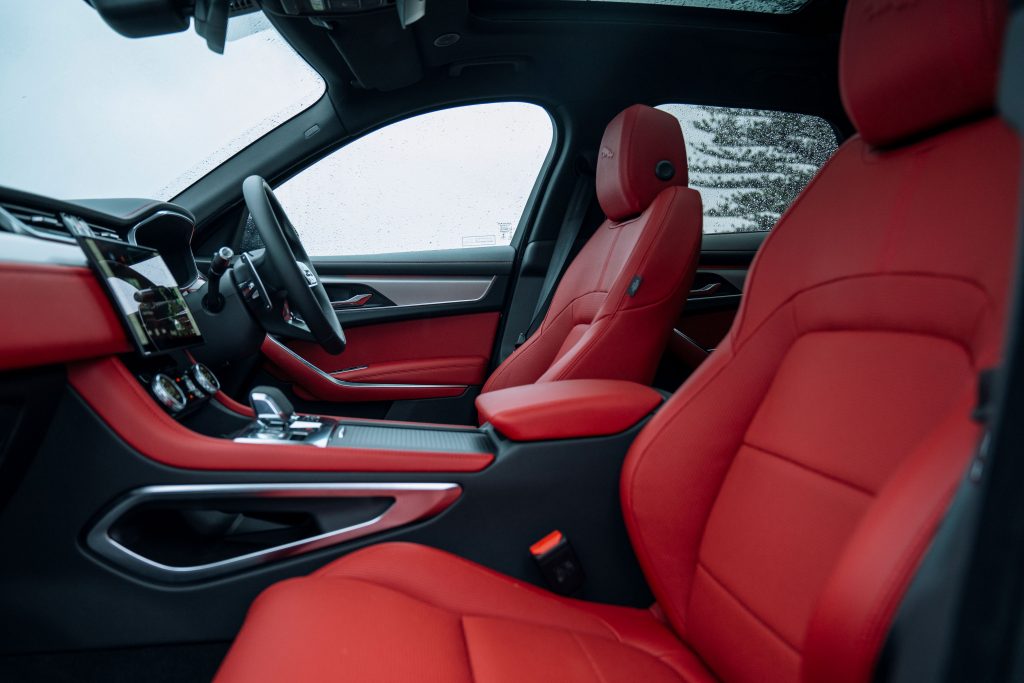
What’s it go like?
Jaguar has been a long-time proponent of aluminium to reduce weight.
A lighter vehicle means better performance and fuel economy, with 80 percent of the body made from aluminium, with additional weight savings through the use of a composite tailgate and magnesium for parts such as the cross member.
The higher torsional rigidity also delivers better handling from the coil over double-wishbone front integral link rear suspension.
Feeding the beast is a 3.0-litre twin turbo six-cylinder diesel, with a mild hybrid that delivers a substantial 221kW of power and 650Nm of torque, the latter from 1500 to 2500 rpm.
Power is delivered to all four wheels through an eight-speed automatic, with paddle shifters and auto engine stop-start to save fuel.
But it’s a torque on demand system so most of the time it operates in two-wheel drive with a bias to the rear wheels.
Together with brake-based torque vectoring and variable electric power steering, this SUV has a lot going for it.
The dash from 0-100km/h takes 6.4 seconds; it has a top speed of 230km/h and uses a claimed 7.0L/100km of fuel.
The hybrid uses a belt integrated starter generator to harvest energy usually lost when slowing and braking.
This energy is stored in a 48V lithium-ion battery for later use to assist in accelerating, as well as delivering a more refined stop/start system.
The latest JaguarDrive Control features four drive modes: Comfort, Eco, Rain-Ice-Snow and Dynamic, that can be selected based on road conditions.
The settings, selected through a new rotary dial next to the drive selector, adjust steering, transmission, throttle and Adaptive Dynamics settings.
Auto vehicle hold provides added convenience and smoother operation than conventional automatic hill hold.
The new technology holds the brakes for an unlimited period of time when stationary on a gradient, gently releasing the brakes when the driver depresses the accelerator to drive away.
Adaptive surface response is designed to distinguish between different low traction surfaces, like mud, ice, gravel, and snow and delivers the ideal torque split for the conditions.
Sounds good, but many reviewers find it hard to get past the badge.
Just because it’s a Jag, doesn’t mean it’s perfect. In fact, we believe there’s a case for ‘blind’ reviews – that is not knowing the brand of vehicle you’re testing.
F-Pace presents well and has the requisite ambience, with tobacco-coloured leather, offset by mood lighting, stainless steel trim and earthy tones for the infotainment system.
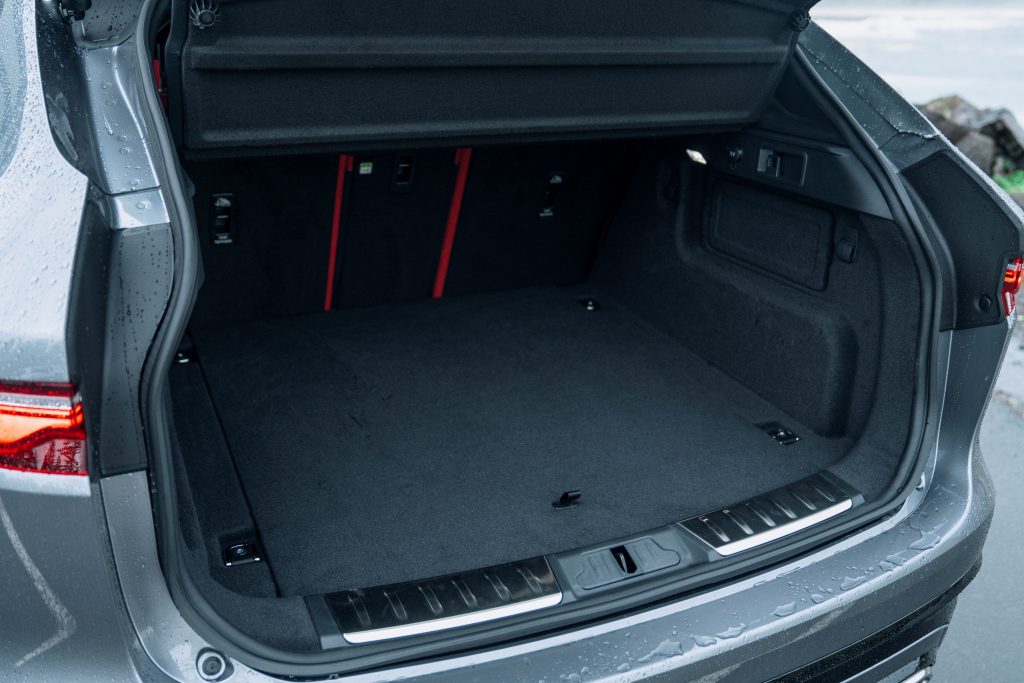
But for a big car it has surprisingly little room in the back seat and the raked roofline could find you ducking to avoid bumping your head.
The boot on the other hand is quite large at 755 litres with the seats up, suggesting the design is skewed towards two people and plenty of luggage at the expense of their passengers.
The part analogue/part digital instrument cluster, features a central 7.0-inch mitred digital display that is mortised between two analogue dials.
While the design looks interesting, in a chronograph kind of way, the digital part is busy and difficult to interpret on the move.
A full 12.1-inch ‘interactive’ display is an $845 option.
The air controls adopt a different approach too, changing between fan, temperature and seat heat levels with a push or pull of the knobs.
Once you discover how it works it’s okay, but it’s hardly what we’d call intuitive.
Entry is keyless. You push a button to start. Then grip the low-profile transmission lever, tucking your fingers over the front to release the selector lock.
To disengage the electric parking brake, it is necessary to tap the accelerator which releases with a start if you happen to be parked on a slope. Not such a good idea?
There’s more than enough oomph from the 650Nm diesel to barrel off the line and the car is extremely quiet for a rattler, but throttle response is jerky and can make it difficult to manoeuvre at low speed.
Ride quality is pretty damned good, even in sport mode, but the adaptive suspension (or is it the adaptive surface response?) generates an inconsistent and sometimes jiggly feel in the default comfort mode.
It’s not as bad as air suspension, but not as good as plain old springs. Sport mode is your friend, but needs to be selected with each start.
The optional panoramic sunroof fitted to our car comes with a retractable gauze screen to keep out glare, but struggles to exclude the heat of the sun.
With a 68-litre tank, we were getting 8.0L/100km after close to 400km.

What we like
- It’s a Jag
- Stylish looks
- Quickish
- Ritzy interior
- Biggish boot
- Doesn’t use much fuel
What we don’t like
- Big heavy doors
- Limited rear legroom
- Difficult to see vehicle extremities
- Twitchy ride from adaptive suspension
- Heat passes through sunroof shade
- Infotainment system requires too much thought
What over-50 drivers need to know
While Jaguar is now owned by the Indians, they have been wise to let them get on with the job.
With Callum gone and plans to go all-electric by 2025, there’s big changes ahead and cars like this diesel F-Pace will soon cease to exist.
If you fancy one and you have $100K sitting around waiting to be spent, may we suggest you get one while the getting’s good?
Being an SUV, it sits higher and is older-driver friendly, and being a modern iteration of the esteemed British marque this one is unlikely to breakdown – or at least that’s the theory.
But like all cars the F-Pace is not perfect, so please take note of the points we have mentioned.
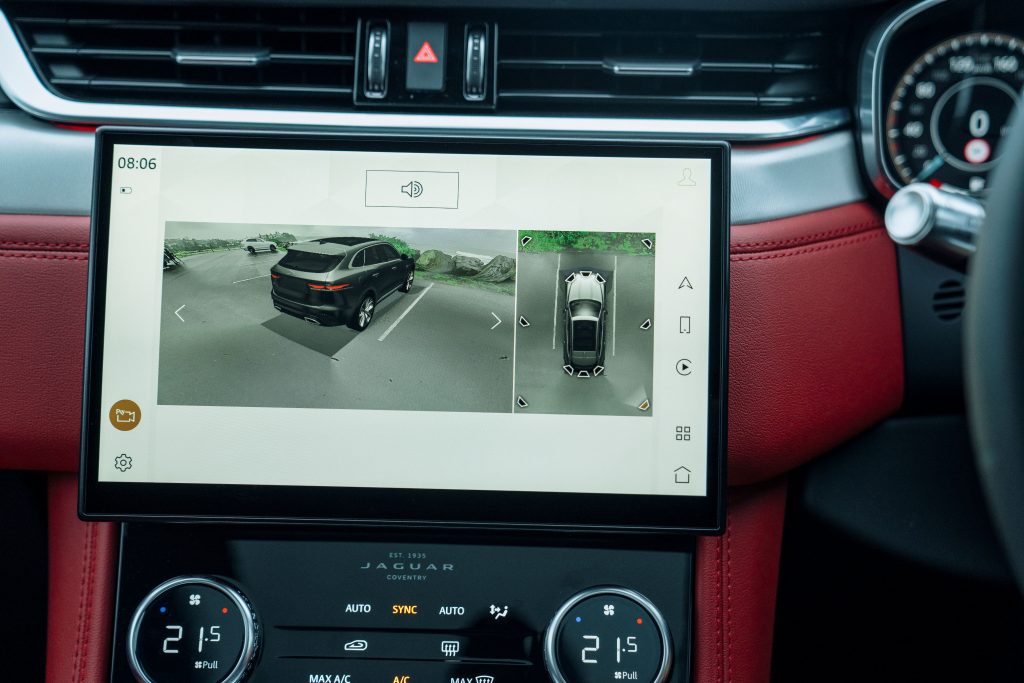
seniordriver comments
Big SUVs like the Jaguar F-Pace simply don’t make good sense in an urban environment, and yet people continue to buy them and then struggle to park them, or manoeuvre them through tight spaces and narrow roadways.
Jaguar will miss the very talented Ian Callum – his influence on Jaguar design has been immense, and it will be interesting to see which way Jaguar styling goes now that he has left the company.
A real consideration with the F-Pace will be how many options you wish to specify. As you can see from the list at the top of this review, you can push the list price well north unless you constrain yourself while ticking those options boxes.
We’d normally call Jaguar out for fitting a tyre repair kit when 22-inch wheels are specified, but since the F-Pace is unlikely to spend much (or any) time off-road, it may not be such an issue for most people.
Once again, we draw your attention to the ANCAP rating. Even though the F-Pace carries a five-star safety rating, it was tested in 2017, so that may be about to expire.
We’re not fans of parking brakes that require a tap on the accelerator to disengage; too often, this results in an unexpected and unwanted leap forward. In a tight parking space, especially when facing uphill, this can cause problems.
Another of our regular gripes appears on the F-Pace. The optional panoramic sunroof is fitted with a retractable gauze screen. These are simply not suitable for Australian conditions, and you may find the interior of the F-Pace becoming uncomfortably hot, even on relatively mild days.
